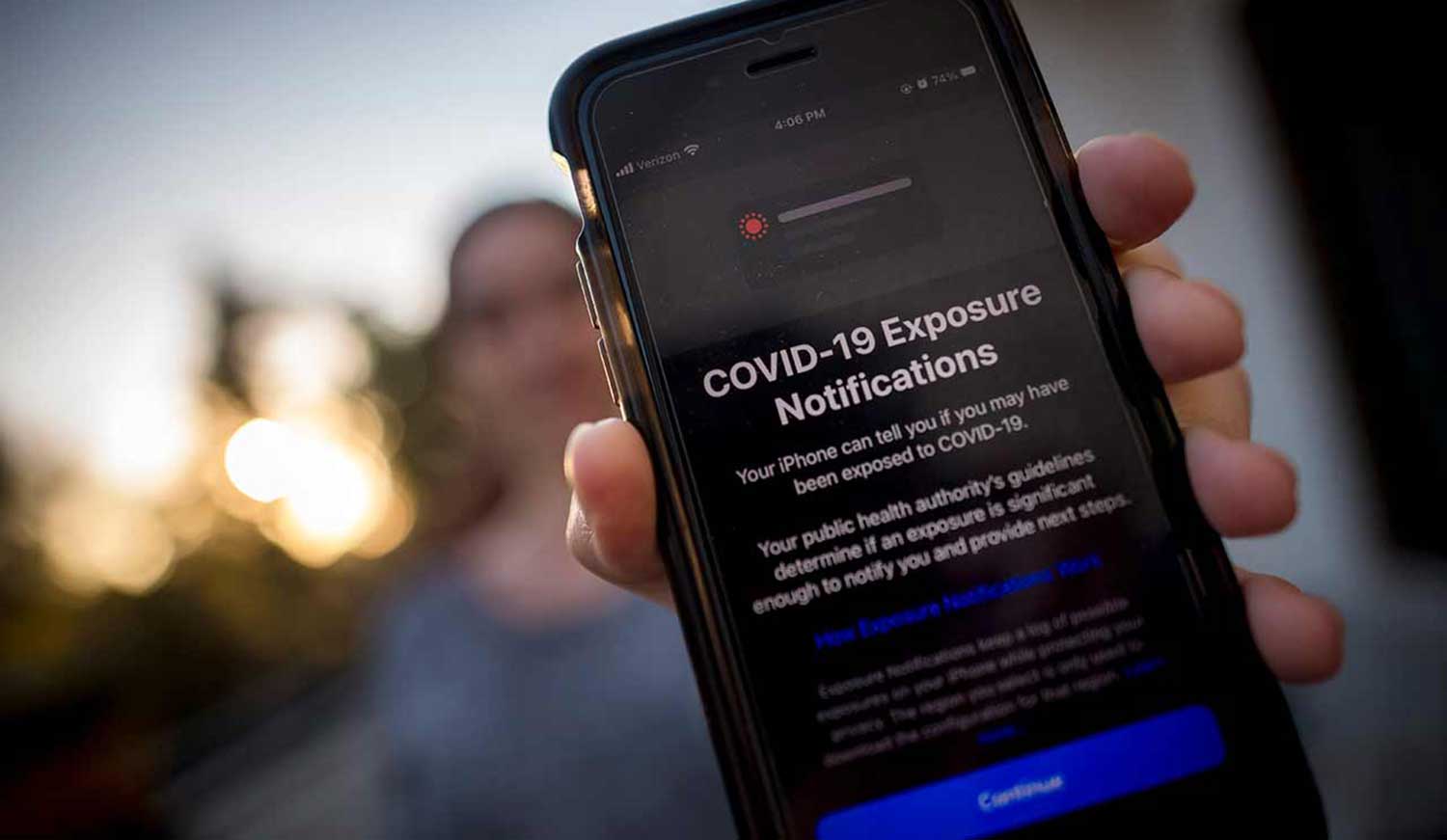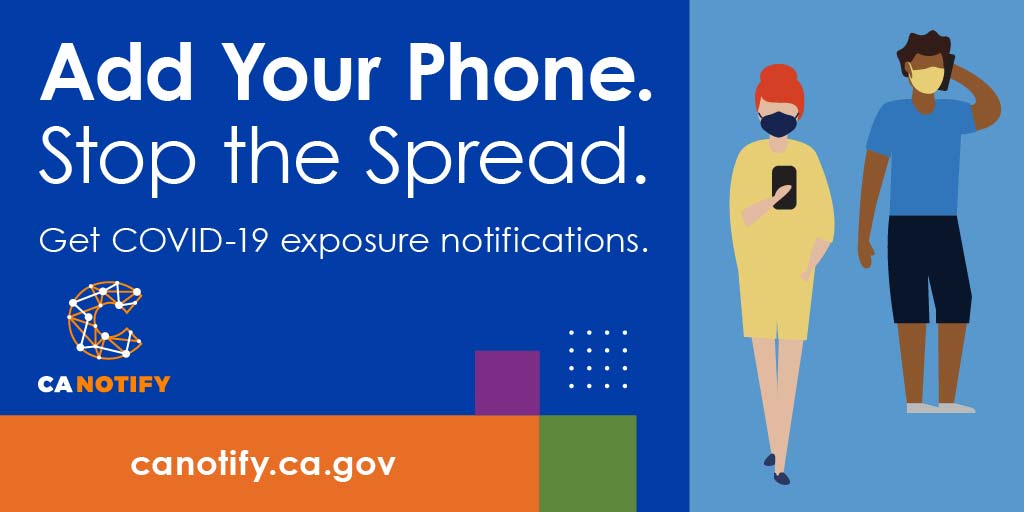
By:
- Erika Johnson
Published Date
By:
- Erika Johnson
Share This:

Q&A: ‘CA Notify’ Exposure Notification System Piloted at UC San Diego Launches Statewide
In September 2020, UC San Diego students and employees became the first participants of the CA Notify smartphone tool, which works behind-the-scenes to automate exposure notification among people who have been in close proximity of each other, augmenting traditional contact tracing. More than half of the on-campus population adopted the app within the first month of launching the pilot program, and over 50 anonymous exposure notifications were issued at UC San Diego during the10-week pilot.
Due to the early successes at UC San Diego—and subsequently six other University of California campuses—the program has expanded statewide in partnership with UC San Diego Health. This means that nearly 26 million people can now activate exposure alerts and respond with self-quarantine and testing with the goal of reducing the amount of SARS-CoV-2 virus spread.
Q. How does the CA Notify app work?
A. The CA Notify app uses a smartphone’s Bluetooth capabilities to alert people if they have been in close contact—within six feet of someone for 15 minutes in a single day—with someone who tested positive for the novel coronavirus in the last 14 days.
When the app is activated, your smartphone will generate and transmit random codes with the phones of others who have opted in without revealing any information about the users. When phones come within six feet of each another, they log one another’s IDs—without names or locations attached. These codes change every 10 to 20 minutes to further preserve your identity and privacy.
If a user later tests positive for COVID-19 and agrees to share that information with CA Notify, then the other people will receive an alert that they have been exposed. That notification will include instructions on who to contact and what to do next.
Q. When did the CA Notify pilot begin at UC San Diego?
A. The pilot program was approved Sept. 11, and UC San Diego began to roll out the program during move-in week in late September, the first University of California campus to do so. The smartphone app was offered to all university students, staff and faculty. The pilot was subsequently launched at UC San Francisco in early October, followed by UC Berkeley, UC Davis, UCLA, UC Riverside and UC Santa Barbara in mid-November.
Q. Why was UC San Diego chosen to lead the pilot?
A. Leaders from UC San Diego were involved in advocating for this technology in partnership with public and private officials locally and in Sacramento starting in spring 2020. In addition, UC San Diego’s Return to Learn program allowed for more students to safely return to campus than any other university in California, which made it an optimal pilot site.

Q. When did California adopt the system for individuals across the state?
A. CA COVID Notify become available to all in California on Dec. 10—nearly 26 million smartphone users. The statewide expansion was announced by the Office of the Governor of California and is led by the California Department of Public Health and California Department of Technology in partnership with UC San Diego Health. Due to its pivotal role in piloting CA Notify, UC San Diego Health is contracted to provide infrastructure, education and support for the exposure notification system, including a call center and public website. The call center answers questions about the mobile tools and how they work on Google and Apple devices. Call center representatives and the website provide support in multiple languages, including Spanish and Chinese.
Q. How did the initial pilot program at UC San Diego help shape the statewide expansion?
A. The UC pilot program provided key lessons on how best to support the use of this technology for all Californians. The pilot was designed to allow UC San Diego to rapidly incorporate real user feedback into communications about the use and benefits of the application. With each new iteration of the website and messaging, adoption of the application increased. All of this feedback is now integrated into the program support of the call center and website.
Q. How many UC San Diego campus members use the app?
A. For every person that activates and uses the CA Notify system, the greater the possibility of quick detection. UC San Diego experienced an adoption rate of more than half of on-campus students and employees within the first week of the pilot program in September. Since then, over 25,000 UC San Diego employees and students—more than 50% of the on-campus population—are now using the system. In addition, the technology became available to all recent patients within the UC San Diego Health System on Nov. 23, growing the user base by up to 350,000 in the San Diego region. As a result, more than 50 COVID-19 exposure notifications have already been anonymously triggered to help protect the campus community.
Q. How is user privacy protected?
A. The voluntary exposure notification program does not share who you are or provide any unnecessary digital details that could compromise privacy. The system does not collect, track or store users’ location, GPS information, or personal information. User identities are not shared with anyone, including Apple and Google.
Users may turn the system on or off at any time or uninstall the app on an Android device. Phones will record the day that the anonymous keys were received, the duration of the signal, and the distance between the two phones (using Bluetooth signal strength as an approximation). These keys are stored on your phone for 14 days, then automatically deleted.
Q. What happens if I receive a notification or test positive?
A. If an individual tests positive for COVID-19, they can choose to share their anonymous keys with other app users to notify them of a possible exposure. Sharing this information helps others protect themselves and helps slow the spread of the virus.
To do this, a verification code will be sent from a medical provider, lab or public health contact tracer that will allow their anonymous keys to be uploaded to a server to activate notifications to other users. This generates an anonymous alert to other users who have opted into the notification system. A notification may read: “Alert: You have recently come in contact with someone who has tested positive for COVID-19. Please quarantine and talk to your health care provider about COVID-19 testing.”
Q. How does the app complement UC San Diego’s own internal contact tracing efforts?
A. CA COVID Notify is a critical tool that complements UC San Diego’s Return to Learn program interventions such as face masking, physical distancing, hand washing, and regular symptom screening and testing. The exposure notification process augments—but does not replace—contact tracing. The app is particularly important for those individuals who are asymptomatic and do not realize they have been exposed to the SARS-CoV-2 virus in a public place, which manual contact tracing would not identify.
The CA COVID Notify app is one of several methods UC San Diego employs to keep the campus community safe. Learn more about the university’s safety guidelines.
Share This:
You May Also Like
Stay in the Know
Keep up with all the latest from UC San Diego. Subscribe to the newsletter today.


